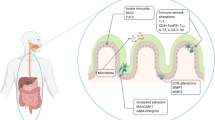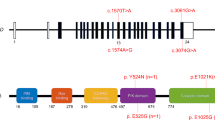Abstract
Ulcerative colitis (UC) has been considered a Th2- and Th17-related disease. However, anti-IL-12/23 p40 antibody, which blocks Th1 and Th17 cell induction and maintenance, has shown efficacy in treating UC, suggesting that UC might not be a prototypical Th2 and Th17 cell-mediated autoimmune disease. To verify how the immune responses in UC patients interact with each other, we analyzed the cytokine expression and transcription factors involved in the Th1, Th2, and Th17 responses. The mucosal expression of 19 cytokines and transcription factors related to Th1, Th2, and Th17 cells, as well as Tregs, were measured by quantitative polymerase chain reaction using endoscopic biopsy specimens from inflamed colons of UC patients. A correlation analysis between the cytokines and transcription factors was conducted. The characteristic cytokine profile in UC patients has two immune response clusters: Th17-related responses and Th1-/Th2-related responses. IL-23 showed a weaker association with Th17 cell-related cytokines and transcription factor RORC and a much stronger correlation with T-bet and GATA3. In the high-IL-23-expression group, the rate of chronic continuous type was higher and the remission rate lower than in the low-IL-23-expression group. IL-23 may be a very important cytokine for evaluating the UC disease condition, as the expression of IL-23 is associated with certain clinical characteristics of UC patients. A unique association between IL-23 and T-bet/GATA3 might play a key role in the pathogenesis of UC.




Similar content being viewed by others
Data Availability
The authors confirm that the data supporting the findings of this study are available within the article and material.
References
Morrison, G., B. Headon, and P. Gibson. 2009. Update in inflammatory bowel disease. Australian Family Physician. 38: 956–961.
Geremia, A., P. Biancheri, P. Allan, G.R. Corazza, and A. di Sabatino. 2014. Innate and adaptive immunity in inflammatory bowel disease. Autoimmunity Reviews. 13: 3–10.
Xavier, R.J., and D.K. Podolsky. 2007. Unravelling the pathogenesis of inflammatory bowel disease. Nature. 448: 427–434.
Rosen, M.J., R. Karns, J.E. Vallance, R. Bezold, A. Waddell, M.H. Collins, Y. Haberman, P. Minar, R.N. Baldassano, J.S. Hyams, S.S. Baker, R. Kellermayer, J.D. Noe, A.M. Griffiths, J.R. Rosh, W.V. Crandall, M.B. Heyman, D.R. Mack, M.D. Kappelman, J. Markowitz, D.E. Moulton, N.S. Leleiko, T.D. Walters, S. Kugathasan, K.T. Wilson, S.P. Hogan, and L.A. Denson. 2017. Mucosal expression of type 2 and type 17 immune response genes distinguishes ulcerative colitis from colon-only Crohn’s disease in treatment-naive pediatric patients. Gastroenterology. 152: 1345–1357.
Hirahara, K., and T. Nakayama. 2016. CD4+ T-cell subsets in inflammatory diseases: beyond the Th1/Th2 paradigm. International Immunology 28: 163–171.
Imam, T., S. Park, M.H. Kaplan, and M.R. Olson. 2018. Effector T helper cell subsets in inflammatory bowel diseases. Frontiers in Immunology. 9: 1212.
Iboshi, Y., K. Nakamura, E. Ihara, T. Iwasa, H. Akiho, N. Harada, M. Nakamuta, and R. Takayanagi. 2014. Multigene analysis unveils distinctive expression pro files of helper T-cell – related genes in the intestinal mucosa that discriminate between ulcerative colitis and Crohn’s disease. Inflammatory Bowel Diseases 20: 967–977.
Feagan, B.G., W.J. Sandborn, C. Gasink, D. Jacobstein, Y. Lang, J.R. Friedman, M.A. Blank, J. Johanns, L.L. Gao, Y. Miao, O.J. Adedokun, B.E. Sands, S.B. Hanauer, S. Vermeire, S. Targan, S. Ghosh, W.J. de Villiers, J.F. Colombel, Z. Tulassay, U. Seidler, B.A. Salzberg, P. Desreumaux, S.D. Lee, Loftus EV Jr, L.A. Dieleman, S. Katz, P. Rutgeerts, and UNITI–IM-UNITI Study Group. 2016. Ustekinumab as induction and maintenance therapy for Crohn’s disease. New England Journal of Medicine. 375: 1946–1960.
Sands, B.E., W.J. Sandborn, R. Panaccione, C.D. O'Brien, H. Zhang, J. Johanns, O.J. Adedokun, K. Li, L. Peyrin-Biroulet, G. van Assche, S. Danese, S. Targan, M.T. Abreu, T. Hisamatsu, P. Szapary, C. Marano, and UNIFI Study Group. 2019. Ustekinumab as induction and maintenance therapy for ulcerative colitis. New England Journal of Medicine. 381: 1201–1214.
Reinisch, W., J. Panés, S. Khurana, G. Toth, F. Hua, G.M. Comer, M. Hinz, K. Page, M. O'Toole, T.M.D. Moorehead, H. Zhu, Y.H. Sun, and F. Cataldi. 2015. Anrukinzumab, an anti-interleukin 13 monoclonal antibody, in active UC: efficacy and safety from a phase IIa randomised multicentre study. Gut. 64: 894–900.
Danese, S., J. Rudziński, W. Brandt, J.L. Dupas, L. Peyrin-Biroulet, Y. Bouhnik, D. Kleczkowski, P. Uebel, M. Lukas, M. Knutsson, F. Erlandsson, M.B. Hansen, and S. Keshav. 2015. Tralokinumab for moderate-to-severe UC: A randomised, double-blind, placebo-controlled, phase IIa study. Gut. 64: 243–249.
Ehrlich, D., N. Jamaluddin, J. Pisegna, and D. Padua. 2018. A challenging case of severe ulcerative colitis following the initiation of secukinumab for ankylosing spondylitis. Case Reports in Gastrointestinal Medicine. 2018: 1–4.
Orrell, K.A., M. Murphrey, R.C. Kelm, H.H. Lee, D.R. Pease, A.E. Laumann, D.P. West, and B. Nardone. 2018. Inflammatory bowel disease events after exposure to interleukin 17 inhibitors secukinumab and ixekizumab: postmarketing analysis from the RADAR (“Research on Adverse Drug events and Reports”) program. Journal of the American Academy of Dermatology. 79: 777–778.
Lozano, M.J.F., R.S. Giménez, and M.C. Fernández. 2018. Emergence of inflammatory bowel disease during treatment with secukinumab. Journal of Crohn’s and Colitis. 12: 1131–1133.
Ogino, H., K. Nakamura, E. Ihara, H. Akiho, and R. Takayanagi. 2011. CD4+CD25+ regulatory T cells suppress Th17-responses in an experimental colitis model. Digestive Diseases and Sciences. 56: 376–386.
Fukaura, K., Y. Iboshi, H. Ogino, E. Ihara, K. Nakamura, Y. Nishihara, K. Nishioka, T. Chinen, T. Iwasa, A. Aso, A. Goto, K. Haraguchi, H. Akiho, N. Harada, and Y. Ogawa. 2019. Mucosal profiles of immune molecules related to T helper and regulatory T cells predict future relapse in patients with quiescent ulcerative colitis. Inflammatory Bowel Diseases. 25: 1019–1027.
Wallner, F.K., M. Hultqvist Hopkins, T. Lindvall, P. Olofsson, and A. Tilevik. 2017. Cytokine correlation analysis based on drug perturbation. Cytokine 90: 73–79.
Allocca, M., F. Furfaro, G. Fiorino, et al. 2018. Can IL-23 be a good target for ulcerative colitis? Best Practice and Research: Clinical Gastroenterology. 32–33: 95–102.
Ueno, A., L. Jeffery, T. Kobayashi, T. Hibi, S. Ghosh, and H. Jijon. 2018. Th17 plasticity and its relevance to inflammatory bowel disease. Journal of Autoimmunity. 87: 38–49.
Li, J., A. Ueno, M. Iacucci, M. Fort Gasia, H.B. Jijon, R. Panaccione, G.G. Kaplan, P.L. Beck, J. Luider, H.W. Barkema, J. Qian, X. Gui, and S. Ghosh. 2017. Crossover subsets of CD4+T lymphocytes in the intestinal lamina propria of patients with Crohn’s disease and ulcerative colitis. Digestive Diseases and Sciences. 62: 2357–2368.
Harrison, O.J., J.L. Linehan, H.-Y. Shih, et al. 2019. Commensal-specific T cell plasticity promotes rapid tissue adaptation to injury. Science. 363: 1–27.
Hirota, K., J.H. Duarte, M. Veldhoen, E. Hornsby, Y. Li, D.J. Cua, H. Ahlfors, C. Wilhelm, M. Tolaini, U. Menzel, A. Garefalaki, A.J. Potocnik, and B. Stockinger. 2011. Fate mapping of IL-17-producing T cells in inflammatory responses. Nature Immunology 12: 255–263.
Globig, A.M., N. Hennecke, B. Martin, M. Seidl, G. Ruf, P. Hasselblatt, R. Thimme, and B. Bengsch. 2014. Comprehensive intestinal T helper cell profiling reveals specific accumulation of IFN-γ+IL-17+coproducing CD4+ T cells in active inflammatory bowel disease. Inflammatory Bowel Diseases. 20: 2321–2329.
Kobayashi, T., S. Okamoto, T. Hisamatsu, N. Kamada, H. Chinen, R. Saito, M.T. Kitazume, A. Nakazawa, A. Sugita, K. Koganei, K. Isobe, and T. Hibi. 2008. IL23 differentially regulates the Th1/Th17 balance in ulcerative colitis and Crohn’s disease. Gut. 57: 1682–1689.
Wakashin, H., K. Hirose, Y. Maezawa, S.I. Kagami, A. Suto, N. Watanabe, Y. Saito, M. Hatano, T. Tokuhisa, Y. Iwakura, P. Puccetti, I. Iwamoto, and H. Nakajima. 2008. IL-23 and Th17 cells enhance Th2-cell-mediated eosinophilic airway inflammation in mice. American Journal of Respiratory and Critical Care Medicine. 178: 1023–1032.
Peng, Juan, Xuexian O. Yang, and Seon Hee Chang. 2010. Jiong Yang and CD. IL-23 signaling enhances Th2 polarization and regulates allergic airway inflammation. Cell Research 20: 62–71.
Gieseck, R.L., M.S. Wilson, and T.A. Wynn. 2018. Type 2 immunity in tissue repair and fibrosis. Nature Reviews Immunology. 18: 62–76.
Oeser, K., C. Schwartz, and D. Voehringer. 2015. Conditional IL-4/IL-13-deficient mice reveal a critical role of innate immune cells for protective immunity against gastrointestinal helminths. Mucosal Immunology. 8: 672–682.
O'Connor, W., Jr., M. Kamanaka, C.J. Booth, et al. 2009. A protective function for interleukin 17A in T cell–mediated intestinal inflammation. Nature Immunology 10: 603–609.
Butera, A., M. di Paola, F. Vitali, D. de Nitto, F. Covotta, F. Borrini, R. Pica, C. de Filippo, D. Cavalieri, A. Giuliani, A. Pronio, and M. Boirivant. 2020. IL-13 mRNA tissue content identifies two subsets of adult ulcerative colitis patients with different clinical and mucosa-associated microbiota profiles. Journal of Crohn’s and Colitis. 14: 369–380.
Acknowledgments
We sincerely thank the staff of the endoscopy unit at Kyushu Medical Center, Kitakyushu Municipal Medical Center, and Harasanshin Hospital for their valuable assistance in conducting this study. We appreciate the technical assistance received from The Research Support Center, Research Center for Human Disease Modeling, and Kyushu University Graduate School of Medical Sciences.
Funding
This study was supported in part by the Japan Society for the Promotion of Science KAKENHI (20K08389).
Author information
Authors and Affiliations
Corresponding author
Ethics declarations
Conflict of Interest
Eikichi Ihara belongs to an endowed course supported by companies including Ono Pharmaceutical Co., Ltd., Miyarisan Pharmaceutical Co. Ltd., Sanwa Kagaku Kenkyusho Co., Ltd., Otsuka Pharmaceutical Factory, Inc., Fujifilm Medical Co., Ltd., Terumo Corporation, Fancl Corporation, and Ohga Pharmacy. All other authors declare that they have no conflict of interest.
Ethics Approval, Consent to Participate, and Consent for Publication
The aim of the present study was explained to each patient during the interview before endoscopy. Patients were informed of the potential risk of bleeding from the biopsy sites although the risk was considered to be low. Only those who gave their written informed consent were included. This study was reviewed and approved by the institutional review boards of all of the study sites and was conducted in accordance with the ethical principles of the Declaration of Helsinki. The study is registered with the Kyushu university hospital under the identification number: 30-472.
Additional information
Publisher’s Note
Springer Nature remains neutral with regard to jurisdictional claims in published maps and institutional affiliations.
Rights and permissions
About this article
Cite this article
Ogino, H., Fukaura, K., Iboshi, Y. et al. Role of the IL-23-T-bet/GATA3 Axis for the Pathogenesis of Ulcerative Colitis. Inflammation 44, 592–603 (2021). https://doi.org/10.1007/s10753-020-01358-y
Received:
Accepted:
Published:
Issue Date:
DOI: https://doi.org/10.1007/s10753-020-01358-y




